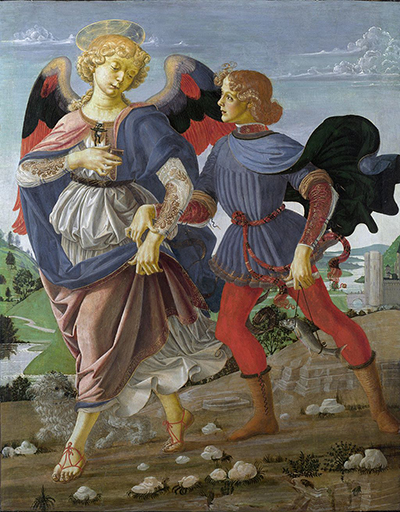Dating from 1475, Tobias and the Angel is the work of the well-known Renaissance painter, Andrea del Verrocchio.
It depicts a scene from the canonical Book of Tobit, wherein a young boy, Tobias, is instructed by his father, the merchant Tobit, to go on a long journey to collect a debt. Tobias walks together with the Archangel Raphael. In the original apocryphal story, Tobias was bathing in the River Tigris when a giant fish leapt out of the water. Raphael instructed Tobias to extract the gallbladder, heart and liver of the fish and use them to create a potion that would heal his father. In the painting, Raphael is seen holding a miniature box that carries the cure. A small dog completes the scene.
The Roman Catholic tradition of the time venerated Archangels. The Church celebrated them as guardian angels who acted as protectors and messengers. Raphael, known as the guardian angel of healing and medicine, comes from the Hebrew meaning "God heals". The story of Tobias and the Archangel was a favourite story in Florence at the time, to the extent that a confraternity of St Raphael developed. The confraternity consisted of a large group of superstitious merchants who came together to perform charitable works. Charity, enterprise and filial piety were the central tenets of the group, and it commissioned a large number of paintings of Raphael - of which Tobias and the Angel was one – before sending their sons abroad to conduct business. In the context of the Renaissance, the picture is considered a devotional work, with the focus on Raphael, as protector of the blind, the young and travellers, rather than Tobias.
Verrocchio was a well-known artist of the era in Florence, Italy. His name, meaning 'true eye' derives from his early patrons, an established Florentine family of benefactors. Although primarily known as a sculptor, Verrochio was a well-regarded painter who worked alongside Sandro Botticello and Filippo Lippi in the latter part of the 15th century. He maintained a popular workshop in Florence, under the patronage of the famous Medici family. Several renowned painters trained with him, including the most famous Renaissance painter of all, Leonardo da Vinci. Notably, some experts believe that da Vinci may be responsible for certain aspects of Tobias and the Angel. Some go so far as to say that the painting was a joint work between Verrochio and his apprentices, including da Vinci, and is, in fact, the earliest da Vinci work yet discovered. The most accomplished parts of the picture – in particular, the dog and the fish – are proposed to be the work of the young da Vinci.
Verrocchio painted Tobias and the Angel using egg tempera, a technique in which ground colour pigment combines with an emulsion of egg yolk and water. Egg tempera is considered one of the oldest painting techniques and was extremely common in the early Renaissance until oil based paint gained prominence. On close examination of the picture, cracked paint is evident on the surface, which is caused by paint drying before the layers underneath are thoroughly dry. The prevalent theory is that this may point to a misunderstanding of the medium, most likely by an inexperienced apprentice. This idea is postulated as another indication that the work was probably a joint effort between Verrochio and his students.
Tobias and the Angel currently hangs in the Sainsbury Wing of the National Gallery in London, which has housed the painting since 1867.




